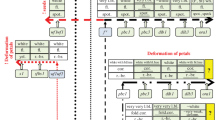Summary
-
1.
The partial inhibitor, Fp, described in the present paper, is quite different in its behavior from Ff, discussed in a previous paper (1926). The factor Fp suppresses the complete development of the white margin in producing it in the “half”-“slight” degrees.
-
2.
The dominance of Fp is almost perfect.
-
3.
The manifestation of this partial inhibitor is subject to fluctuation, contrary to that of the other partial inhibitor (cf.Imai 1926).
-
4.
A strong linkage occurs between the allelomorphic pairs of Fp and fp versus Di and di, the latter controlling the intensity of the flower color, the cross-over value being about 3%.
-
5.
The non-willow-leaf segregates bore flowers with white margin of a high degree, the willow-leaf ones, on the other hand, almost invariably had flowers which were either self-colored or with white margin pattern in a very slight degree. This may be due to another linkage relation.
-
6.
Quite unexpectedly the maple-leaf mutants, produced by mutation of m′→m, have always the white margin in a degree averaging that of the flowers of the cordate-leaf plants.
-
7.
The flowers of disguise-willow, which appeared as a bud-sport on a willow-leaf plant, however, had the average degree of the latter type.
Similar content being viewed by others
References
Frost, B. H., 1921.—An apparent case of somatic segregation involving two linked factors. Amer. Nat., 55: 461–464.
Hagiwara, T., 1926.—Genetic studies of corolla-pattern in the morning glory. II. On the six kinds of the corolla-pattern. Bot. Mag. (Tokyo), 40: 203–225. (In Japanese).
Imai, Y., 1926.—Genetic studies in morning glories. XVII. On the white margin ofPharbitis Nil.Ibid., 40: 496–498. (In Japanese). Its main paper: A genetic analysis of white-margined flowers in the Japanese morning glory. Genetics. (In press.)
Nagai, I., 1926.—Studies on the mutations inOryza sativa L. III. On paleaceous sterile mutant. Japanese Journ. of Botany, 3: 67–84.
Nilsson-Ehre, H., 1920.—Mutiple Allelomorphe und Komplexmutationen beim Weizen. Hereditas, 1: 277–312.
Takezaki, Y., 1916.—Inheritance of the Japanese morning glory. Journ. of the Japanese Breeders' Association, 1–1: 12–12.
Author information
Authors and Affiliations
Rights and permissions
About this article
Cite this article
Imai, Y. Further studies on the genetics of the white margined flower of the Japanese morning glory. Genetica 9, 101–115 (1927). https://doi.org/10.1007/BF01508745
Issue Date:
DOI: https://doi.org/10.1007/BF01508745




